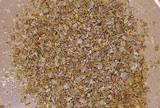Greek name and pronunciation:
At the market:

Marjoram
Physical characteristics:
Usage:
Substitutes:
Origin, History, and Mythology:
Marjoram probably originated in Greece. Today Egypt is the major exporter and it is cultivated worldwide.Both oregano and marjoram are members of the mint family. Many botanists consider marjoram a variety of oregano.
Ancient Greeks planted marjoram on the graves of their beloved in the belief that by doing so the deceased would enjoy eternal peace and happiness. Hippocrates ascribed several medical uses to marjoram. Marjoram was one of the herbs and spices used by the ancient Egyptians in the embalming process. Ancient Greeks and Romans made head wreaths of marjoram for wedding couples as a symbol of love, honor, and happiness.
Medicinally, marjoram is used as a steam inhalant to clear the sinuses and relieve laryngitis. Marjoram tea sweetened with honey helps preserve the voice of professional singers.
